|
China. The Yangtze River starts on the Qinghai-Tibet Plateau in the West and runs almost 4000 miles to the East China Sea, near Shanghai. About 60 miles from there, in the northern part of Zhejiang province, the Yangtze River flows through an exceptionally fertile delta region, and on its southern banks, there is a maze of rivers and canals that flow through the town of Wuzhen, the Venice of Asia. The town’s fluvial beauty has been a magnet for both business and cultural enterprise—including the theatre—since 872 A.D., and for civilized society since the New Stone Age, 7000 years ago. This evening, a gondola has ferried me along Wuzhen’s ancient rivers and waterways to the newly renovated Water Theatre, to see a play that takes place on a lake. Here, I am sitting in a puddle.
Water. The town floats. The houses sit above water level, and inhabitants and visitors appear suspended as they stroll along the walkways above the water. Crossing the footbridges, boats glide under your feet. I’ve just eaten on a high stool in a restaurant surrounded by water. The playing areas for tonight’s performance include a large stretch of water, and beyond it, a stage raised so it seems to hover over the water’s surface. Gondolas rest in the water along both sides of the stage.
The rain started as soon as we arrived at the outdoor theatre. I traded my ticket for a lime green throw pillow and a plastic rain poncho, and settled in. So did the other 1,999 people.
Audience in raincoats, facing stage. On large screen to left, opening the Opening Ceremony, Wuzhen Theatre Festival co-founders Stan Lai and Huang Lei. Venue: Water Theatre, Wuzhen, China. October 30, 2014. © Lissa Tyler Renaud
No one had expected the pre-show Opening Ceremony to have a water theme, but there it was: it rained briskly while two festival founders and other public figures integral to the festival welcomed us; it rained heavily on two Italians waltzing on stilts in full ballroom dress, accompanied by an enormous white balloon, a very small man in formal dress, and a monkey rolling a golden globe. It rained torrentially on the U.K.’s huge puppet from “War Horse,” visiting from its Beijing rehearsals—a moving gesture of support for the Festival in just its second year. And the terrific opening show, “Green Snake,” was deluged with rain.
In Shanghai a few days earlier, when I told my colleague that rain was forecast for much of the festival, he said dreamily: “Ah, Wuzhen is truly Wuzhen when it rains.”
The Festival’s opening show, “Green Snake.” Dir. Tian Qinxin.
A storm in the play, during an actual storm. Photo: www.wuzhenfestival.com
And it was magnificent. As if Nature were collaborating on the show. At its hardest, rain obscured the enormous screens on either side of the stage with the (excellent) translation on it, so I could simply enjoy the visually striking performance in front of me. The actors were slipping, splashing and soaked, their mics shorting out periodically, so that for brief moments their lovely natural voices wafted into the crowd. As the gondolas were hit by rain, they came to life, bobbing dramatically. The beautiful “water curtain”—a scrim for projections, made of water—was matched by natural waters falling in sheets. A scene that included a rain effect, and scenes with parasols for rain—these blended with what was all around all of us, creating a delightful solidarity between stage and audience: we were, literally, in it together.
RAIN. But nobody cared. Everyone was rapt. We were a sea of colors in our shiny coats, swimming in pleasure. We’d come to this out-of-the-way place, and so much had gone into making this evening’s events for us: we weren’t going anywhere! Well into Hour Two, the fellow next to me, who didn’t share a spoken language with me, spoke to me in Umbrella: he opened his immense umbrella over his and my knees, and scooted politely to the far side. Eloquently spoken.
What made everyone stay in the pouring rain? This was not a sports event, or a rock concert; it was theatre. Live theatre.
A couple of days later, when the festival’s Artistic Director, Stan Lai, and I had a few quiet minutes to sit, we just shook our heads. “Crazy,” he said. “Madness,” I said. “Crazy,” he said. “Madness,” I said.
And I think that’s at least part of why we stayed. To participate in this grand gesture that is the Wuzhen Theatre Festival. To be part of this Cecil B. DeMille moment: we were the thousands of extras critical to the show. We were the thousands dragging Herzog’s 360-ton boat over the mountain in “Fitzcarraldo,” so Kinski could build an opera house in the jungle.
Wuzhen. Approximately: OO-djen. I hear the name spoken like the name of someone you have a crush on: noticeably often, and with special tenderness.
* * *
Huang Lei, Producing Director.
Photo: www.vebidoo.de
The town, which was historically characterized in part by its dozens of temples and shrines, has undergone periods of willful government destruction, local neglect and, since the 1990s, fitful architectural preservation efforts that were ultimately bolstered by re-conceiving the town as a destination for tourists to relax and shop while learning about history and traditional handicrafts. Chen Xianghong’s is the name most associated with Wuzhen’s general recovery. It was Huang Lei—actor, director, screenwriter, producer, singer, model, pop star, professor of acting, son and husband of actors, public Humanist and general dreamboat—who, while filming a TV show, first noted the theatrical potential of virtually every nook and cranny of the town. Behind, over, under and around every inch of it, there is a structure or space begging for a performance. Indeed, as first Founding visionary, Huang was everywhere at the Festival: now in a public discussion, now rehearsing, now in a show, now in a gathering for the Festival’s artists—and in each case, it was impossible not to be captivated by his sensibility, humor, and dedication to live theatre.
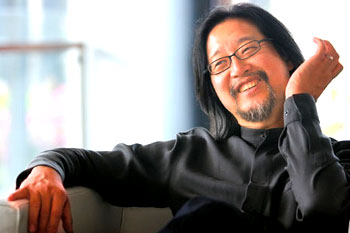 |
Stan Lai, Artistic Director.
Photo: chinaculture.org
On the Festival’s artistic front, Huang Lei was then joined by Stan Lai (Lai Sheng-chuan), whose work I know well. From the BBC and the New York Times to the Beijing News, Lai has been called Asia’s top director and the best playwright in the Chinese language; his plays are routinely described with language such as “masterpiece” and “the pinnacle of our era.” These are dastardly understatements. Over a 30-year period, Lai’s wide-ranging work has led the creation of a theatre culture for Taiwan virtually from scratch, served as an imperative cultural bridge between Taiwan and China, given the Chinese world a contemporary theatre of its own, and given a voice to Chinese diaspora culture. In other words, he has changed a large part of the world. In film, opera and television, he has been exhaustively honored and awarded, in Asia and abroad. As a native speaker of both English and Chinese, Lai is also in a unique position to bring artists of West and East into substantive dialogue—not least through his translations, lectures, best-selling books, and professional friendships around the world—and this is sure to be one of his many visionary contributions to the Festival.
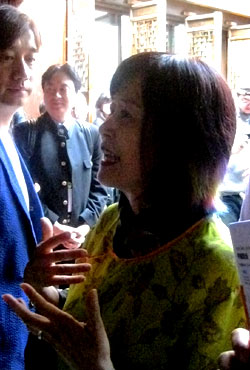 |
Nai-chu Ding, Executive Director.
© Lissa Tyler Renaud
Also foundational to the Festival, Lai brings his more than 30-year enormously fruitful partnership with Nai-chu Ding, the Festival’s Executive Director. Ding is a wonderfully successful producer of theatre and film (and more), in Taiwan and throughout the Chinese-speaking world. Works she produced have won impressive awards in both Asia and Europe and, more importantly, given countless audiences access to powerful achievements in creativity. Ding, who holds degrees in both Philosophy (Taiwan) and Education (U.S.), is also a force in Tibetan Buddhist studies, personally bringing lamas to Taiwan, as well as translating, publishing and teaching their work. As a hostess to this international theatre gathering, and as Lai’s wife, Ding’s breadth—and beauty—also play a critical role in setting the tone for the Festival: elegant, worldly, welcoming and lively.
Meng Jinghui, Artistic Consultant.
Photo: french.chinaculture.org.cn
The third vir of the festival’s artistic triumvirate is Meng Jinghui. Meng tolerates people calling him pioneering or rebellious or China’s most influential theatre-maker or best avant-garde director today—and they do call him those things—as long as everyone will then leave him in peace so he can do his work.
For anyone trying to get a simple, post-it like handle on these unfamiliar Festival names and the work associated with them, one might label Huang Lei an actor, Stan Lai a playwright and Meng Jinghui a director. But really, for each of these artists, his “label” just beats a loud drum at the head of a delirious parade of his talents, interests, affinities, skills, experiments, experience, collaborations, daring and raw hunches. In fact, all three of them actually do anything and everything that might result in a worthwhile piece of theatre, and they all bring to the undertaking an embarrassment of creative riches. In Meng’s case, he is known (renowned) as director of the generation-defining plays by prolific writer (and Meng’s wife), Liao Yimei—but also as the auteur director working with Western texts in the absurdist vein (Ionesco, Beckett, et alia). At the same time, Molière, classical Chinese opera, commedia dell’arte, Ibsen, Dario Fo—any of these is material for what’s come to be known as “Meng-style” theatre, so collaborative in process that he said of his Genet production for Wuzhen: “I prefer to say these plays are produced under my guidance."
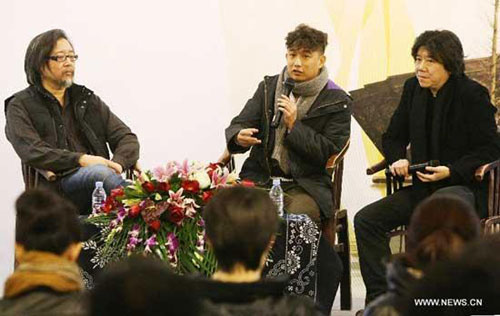 |
Artistic Co-Founders (L to R) Stan Lai, Huang Lei, Meng Jinghui.
© Xinhua/Li Fangyu
What I’ve said of one Festival founder can be said of all three. They are dedicated to live theatre. They have changed a large part of the world. They work collaboratively across genres and disciplines.
Kahlil Gibran wrote: “All work is empty save when there is love." And if part of the reason we stayed in the opening night rain was for the grand gesture of it, the rest of the reason we stayed, for all that followed at the Festival, was the love. There was palpable love in the work: geniuses making live theatre.
* * *
White Snake (Jin Ge) and Green Snake (Yang Yinyin).
Photo: www.news.cn
“Green Snake” was an inspired choice for the opening show. Based on one of China’s oldest legends, the story takes place by what is still West Lake today, which is just over an hour from Wuzhen, in Hangzhou, another magnet town for swooning tourist appreciation. Again, water: the Water Theatre and its wide pool; a play about a lake; that lake nearby. It was a friendly way of introducing foreign guests to this tale, so much a part of Chinese folklore heritage. At the same time, it gave Chinese audiences a stylish, thought-provoking stage version of a story they know, and have likely seen in a re-telling for television, opera, dance or film.
Chinese audiences came to “Green Snake” knowing that the title should really be “White Snake.” The basic legend: 1000-year old snake spirit White, and her companion Green, younger by 500 years, long to enjoy human-ness, especially love. Crossing a bridge in the rain, a fellow lends them an umbrella. He and White fall in love right then, marry, and live together happily. A Monk comes visiting, tells Husband that his wife is a Snake, and that he can test the truth of this by having her drink wine. Test carried out, White turns snake again. From this point on, Husband has to choose over and over again between what he is being told by the Monk (that his wife is a danger), and what he feels (his love for his wife, snake or no). There are battles, gods, magic potions, floods, a monastery, a pagoda with a prison under it, daring rescues and escapes. Traditionally, the tale ended with the monk sealing White underground for eternity.
Dance scholar Hu Ya-Ting gives some context:
Readers can see what “The Legend of White Snake” meant in its time: it was not just a folk story; it was a story that implied a criticism of society. Just as women were oppressed by men, sensitive poets were oppressed by strict cultural values. Therefore, many Chinese scholars, especially poets, used female figures to express the suffering inflicted on them by society or the authorities, so that their stories would sound like simple love stories, rather than revelations of rulers’ wrong-doing.
In “The Legend of White Snake,” we see that the two snake women, in spite of their being more loyal, true, and honest than any human beings… are beaten down and punished by the Monk and the gods, who symbolize societal rules: they are powerful, conservative, lacking human feeling… The tale blames [husband] Xu Xian for being too weak to make any decision… It also warns those [like White] who want to follow their own path that such independence may lead them to be imprisoned forever. [1]
Over the centuries (about six of them), the story has been re-framed countless times for different emphasis. Only a few examples: are the two snakes friends or rivals? Is the monk protecting the husband from harm, or standing in the way of true love? When he sees the snake, does the husband faint and revive, or die of shock and need rescue from the dead? Does the husband refuse to live with his wife, or is he held captive by the monk? Does White give birth to a son, and if so, does he later rescue her from prison?
The production we saw was originally based on Green Snake, by Hong Kong novelist, Lillian Lee Pik-wah. Now there are two pairings: White and her Husband are foils for Green and the Monk. The first couple has achieved domestic fulfillment effortlessly. Green, however, is in a perpetual torment of erotic longing, which she focuses on the Monk—the epitome of the “unavailable partner”—who is at the peak of a struggle with his celibacy. Director Tian Qinxin also brought her own interesting perspective on the story: “[Green] is not psychologically prepared to become a human being… Therefore, she uses her body to explore and confront the human world”; and “[Now] is a time when people have lost their internal compass and desire comes before everything else."
Tian Qinxin © Chen Xu Renren.
It wasn’t a surprise to learn that director Tian is deeply admired for bringing social issues and blazing visuals to her imaginative, contemporizing adaptations of older material. Or that she also trained in classical Beijing opera, techniques that add further dimension to her up-to-the-minute productions. These are exactly what I saw in her “Green Snake.”
Here, with the character of Green at the fore, the play addresses today’s particular incarnation of issues surrounding relationships, emotional authenticity, religious beliefs, the erosion of conventions, the questioning of authority. The staging married traditional elements with a pop aesthetic, an avant-garde vein, extravaganza numbers with forty monks in formation, anime references, high- and low-tech effects, and a kind of Pirandellian meta-discourse with the audience: the Monk, for example, complained to the audience that they were responsible for his centuries-old bad reputation, and distanced himself from various plot turns with “This wasn’t my idea!” Like Abel Gance’s audacious battle scene with horses galloping across three screens (“Napoleon,” 1927), in this production, a panoramic storm played out across the two huge screens and also incorporated the surfaces of adjacent ancient buildings: stunning.
The show started out looking as if it would be a conventional, even formal telling of the story. But it quickly became Modern as big sister White and teen princess Green hit the stage with their slinky variety of fairytale appeal. White was the kind of young woman who is happy with mainstream kinds of happiness. She is satisfied to get married and have a baby (or to get pregnant and then married). She is the yearning-for-a picket-fence sort of person. Green, on the other hand, is the embodiment of “today’s youth,” all Instant Gratification. Her head is full of superficial ideas about what a Life looks like, she feels that her beauty should make other people do what she wants, and supposes that her high energy alone will make up for her lack of real knowledge. Whatever she wants, she wants now. And what she wants first is White’s new boyfriend, and then the handsome, celibate Monk.
I have to say that the production’s treatment of sexual desire, both fulfilled and unfulfilled, was very frank indeed. When White and her new love disappeared inside a gondola, believe me, they rocked that boat and the audience roared with laughter. When Green contended with White for her boyfriend, Green simply grabbed him, wrapped herself around him, and pulled. When Green set her sights on the Monk, there was no coquetry: she leaped on him and wrapped her legs around his waist; she tackled him, wrassled him to the ground, cooed and stroked him, pleaded and demanded, well, sex—and of course love, but… sex. And the Monk’s predicament, trying to negotiate between his healthy desire and his commitment to abstinence, was portrayed without inhibition, both hilariously and painfully. This production’s candid exploration of lust as a motivator was completely unexpected and refreshing.
It was also part of the Festival’s mission to interest young audiences in the theatre. Not to bring them in as a new source of ticket revenue; not by giving them theatre “games” to play. The Wuzhen Festival was showing the next generation How It’s Done, by Artists who know how, and are doing it. Letting the next generation get to know up close the theatre’s ragtag splendor, so different in quality from the fake sheen of blockbuster films and music videos. Giving the young a chance to learn from the experienced, to respect and love the theatre’s peculiar magic, so they’ll know what it is if they want to make it themselves.
Green Snake (Yang Yinyin), White Snake’s beloved (Dong Chang),
and White Snake (Jin Ge). Jealousy. © Jie Fei
So yes, the language in “Green Snake” shifted between heightened and Teen Speak: Hey dude, and, Why are we hanging around with these jerks. There were popular culture puns, and cartoonish sequences, and even a little history lesson towards the end, about the real-life Monk in the mid-900s. The production also raised questions about young-people matters: Should you sleep together before knowing each other? (It’s complicated.) Should you hang around if you get your girlfriend pregnant? (Usually.) Should you stay around after the baby is born? (Yes!) What are the limits of friendship? (None.) Can “alien beings” love? (Yes.) Can they learn the ways of others and live among them? (Mostly.) Can you tell a book by its cover? (Yes and no. The scary snakes turned out to be loving and faithful, but the essential natures of snake spirit and human are different.)
Actually, that last “yes and no” says a lot. Everyone I talked to during the Festival about “Green Snake” was absolutely enthusiastic. And not a single one of us could say what happened at the end. In a typical Western theatre production, this would have been a flaw and ruined the pleasure. Here, the not-knowing was surprisingly moving. The Monk, for example, was stern and moralistic, and endured a lot of teasing for being inflexible. But right and wrong were as hard to identify here as they are in life. By the end, the Monk had made some compromises (though not to his chastity) and even shown his respect for White’s wisdom and enduring love for her husband. But was the production really suggesting that celibacy wins out in the end? It was charming to see Green displeased with the ending: Some people, she said as she flounced offstage like a miffed teenager, call this a good ending! But just because she is questioning, is her point of view more right than anyone else’s? In fact, rather than “take sides,” all we can do is say that some things happened and others didn’t: things are what they are. There was love between White and Green, between husband and wife, parents and child; there was a flood, monks died, people were imprisoned. But what does it all mean? That isn’t ours to say.
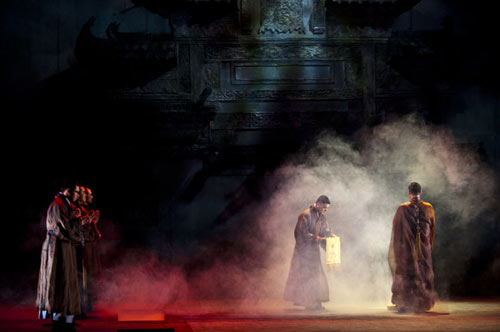 |
At the gates to the Buddhist Temple.
Monks and the Monk Fahai (Dong Chang).
Where desires are tamed, or imprisoned.
Photo: english.cri.cn
Tian called “Green Snake” her “first attempt to put forward a contemporary and international expression of the Zen spirit.” Certainly we could see that it was the characters’ desires that kick-started the play’s events: the snake spirits wanted to become human, and the monks wanted to become Buddha. The script also had a kind of circular structure that could be tiring for those used to drama where the action is always moving forward. The Husband seemed to meet the same conflict repeatedly—to accept his wife or not—with nothing new added as the problem came around again. On the one hand, this could be because the script has gotten away from them: it’s been greatly lengthened and shortened for different occasions as it has traveled around, and it was made anew for this Festival and the Water Theatre. On the other hand, the repetition might make a Groundhog Day sort of point: remember Bill Murray stepping in that exact same puddle, time after time, until he finally became aware of what he was doing.
When the show ended and Tian came onstage, we got to see that the Merlin of this production was a pleasant woman in baggy jeans and sports sneakers, with a loose-fitted black smock-coat and cropped hair. Her appearance added a whole new level of things to think about. So it was disappointing to come across a remark like this one quoted in an interview: “I think Chinese artists must have a strong consciousness and utilize the excellence of their artistic minds to deliver complex ideas in an easily understandable manner for foreign audiences.” The dumbing-it-down-for-foreigners stance is always a cheap game. So I’ve simply decided Tian didn’t say it: there was a problem with the translation, or the remark was taken out of context, or she said it but didn’t mean it “that way.”
And she made an important distinction here: “I think introducing Chinese culture abroad through traditional operas and acrobatics can at most achieve the effect of making foreigners appreciate but not truly spread Chinese culture. Chinese culture is too deep and abstract to be translated in a straight-forward manner.” Surely one of the very most admirable achievements of her production was that it went beyond only the outré costumes and refined derring-do that foreign audiences usually know of China from touring shows. Tian found ways to handle complex themes.
For my part, of course I often had to be satisfied with enjoying the Chinese-speaking audience’s response to jokes or cultural references. But the show was clear enough that I could fill in the gaps with my own rich associations: the poignant Ondine story, for example, of the mermaid who longs for human love and hearth until she has to live with the consequences of having her wish granted. Ondine is surely the spiritual sister of White and Green. And as far as the meaning of it all goes? Near the end of his life, when Olga Knipper asked her husband, Anton Chekhov, the meaning of life, he replied: “It is like asking what a carrot is. A carrot is a carrot and nothing more is known.” Surely at least a cousin of the Zen spirit present in Tian’s production of “Green Snake.”
* * *
The rain stopped as soon as we stood up to go, which increased the uncanny feeling that Nature had been an active participant in the evening’s proceedings.
That puddle I was sitting in? It was a privilege.
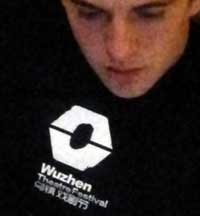
Footnote:
[1] Quoted from “The Legend of the White Snake” in Contemporary Dance in Cultural and Political Conversation with Its Audiences, by Hu Ya-Ting. Unpublished Master’s Thesis in Dance (U.S.) Ms. Hu also has a B.A. in Chinese Literature and an M.F.A. in Acting (Taiwan).
Further Viewing and Reading about the Festival and its founders, in English:
Huang Lei
Interview: Wuzhen, Huang’s inspiration for the Festival, Festival clips
http://www.chinaontv.com/china_videoplayer_cityfocus.php?pid=7780&part=1 (6:54)
Stan Lai (Lai Sheng-chuan)
Lecture: “Creative Visions for the Coming Decade”
Clip from Lai’s groundbreaking “Secret Love in Peach Blossom Land” (a classical and a contemporary play are booked into a theatre to rehearse at the same time) https://www.youtube.com/watch?v=ZyvkwNPNWZw (1:51)
Meng Jinghui
Good introductory article on Meng Jinghui, 2006
http://www.china.org.cn/english/NM-e/181183.htm
Television interview (subtitles)
https://www.youtube.com/watch?v=nnLz14hGbFc (1:57)
Chicken Poets
Clip from Meng’s 2002 avant-garde film (shot in 35mm)
https://www.youtube.com/watch?v=be5XOuKHRKc (0:41)
The White Snake Legend
A delightful telling of it
http://www.aaronshep.com/stories/062.html
Wuzhen Theatre Festival website
Note: The 3rd annual Festival will be from October 16 to 25, 2015
www.wuzhenfestival.com/en/
Cover Photo: Taken minutes from the Water Theatre
where the Opening Ceremony was held. © Lissa Tyler Renaud
|